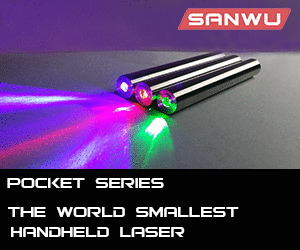Bluefan
0
- Joined
- Aug 15, 2009
- Messages
- 1,443
- Points
- 48
A while back I measured the output of all the diodes while they were still connected to the c@$10 A14O projector. I though I should post the results so people can see what comes out of a projector.
The diodes are running pulsed inside the projector. On the ECO setting the frequency is 120Hz and a 50% duty cycle, or 4.2ms on with a 8.4ms period. With the ECO off it goes to full power, but now it's 3.4ms on with a 8.4ms period, a shorter 40% dutycycle at 120hz.
I numbered the diodes like you would see them if you look at the array headon:
I haven't got the beam profile pictures here, but here is the measured power in milliwatts:
It's very interesting to see that the diodes in the middle of the array are the most powerfull and the diodes at the sides less powerfull. You can multiply the full power column by 2.5 to get the peak power the diodes run at which regularly hits 2W.
The diodes sold here on the forum and everywhere else are usually not tested, the most powerfull diode is a whopping 40% more powerfull compared to the least powerfull diode (585mW vs 820mW). This spread may also be present in our builds, as I assume all the diodes in the projector are ran at the same current. So the regularly made assumption of 1A -> 1W is also affected by this. Without a power meter you can't be that certain about the output power.
And last but not least a photo of the setup at my university, I used a piece of black painted metal with a 6mm hole to pass the beam through. The measurements aren't that precise, the power was drifting and fluctuating a bit, and the alignment of the metal piece wasn't perfect every time. On the left is the Melles Griot power meter I used. I placed a fan next to the diode array to keep it cool.

The diodes are running pulsed inside the projector. On the ECO setting the frequency is 120Hz and a 50% duty cycle, or 4.2ms on with a 8.4ms period. With the ECO off it goes to full power, but now it's 3.4ms on with a 8.4ms period, a shorter 40% dutycycle at 120hz.
I numbered the diodes like you would see them if you look at the array headon:
Code:
17 18 19 20 21 22 23 24
9 10 11 12 13 14 15 16
1 2 3 4 5 6 7 8
at this side is the flat cable.I haven't got the beam profile pictures here, but here is the measured power in milliwatts:
Code:
diode eco full
1 575 600
2 610 640
3 560 585
4 730 790
5 755 820
6 720 780
7 725 660
8 600 640
9 610 660
10 675 755
11 725 785
12 745 805
13 720 785
14 675 730
15 680 750
16 645 710
17 625 770
18 700 755
19 755 820
20 755 820
21 705 770
22 635 700
23 635 695
24 620 675It's very interesting to see that the diodes in the middle of the array are the most powerfull and the diodes at the sides less powerfull. You can multiply the full power column by 2.5 to get the peak power the diodes run at which regularly hits 2W.
The diodes sold here on the forum and everywhere else are usually not tested, the most powerfull diode is a whopping 40% more powerfull compared to the least powerfull diode (585mW vs 820mW). This spread may also be present in our builds, as I assume all the diodes in the projector are ran at the same current. So the regularly made assumption of 1A -> 1W is also affected by this. Without a power meter you can't be that certain about the output power.
And last but not least a photo of the setup at my university, I used a piece of black painted metal with a 6mm hole to pass the beam through. The measurements aren't that precise, the power was drifting and fluctuating a bit, and the alignment of the metal piece wasn't perfect every time. On the left is the Melles Griot power meter I used. I placed a fan next to the diode array to keep it cool.
Attachments
Last edited:




